What if you came to work one day only to find out that half your customer base left you for your competition?
If you’ve just felt cold sweats thinking about revenue drops, acquisition costs, and all this year's KPIs going to hell… Good. Because that’s what you’re risking when you ignore customer satisfaction.

To say that customer satisfaction is important is an understatement. In 2023, it’s a necessity. According to Gartner, 81% of marketers view customer satisfaction as the main competition area in their industry.
But the competitive edge is not all. PwC found that 59% of customers will give up on a company after several bad experiences, and 17% after one bad customer experience. Yes, this also applies to your previously loyal customers. And yes, they won’t be back.

As you see, you can’t underestimate the importance of customer satisfaction. It’s the best way to secure loyal customers who’ll eventually turn into brand ambassadors. Every company should treat customer satisfaction as an essential business factor and work on improving it.
In this article, you’ll find the answers to the following questions:
- What is customer satisfaction?
- Why is customer satisfaction important?
- How to improve customer satisfaction?
Let’s roll!
Free-to-use customer satisfaction survey (CSAT) template
What is customer satisfaction?
In simple words, customer satisfaction is a measurement that determines how well a company’s products or services meet customer expectations. It’s one of the most important indicators of purchase intentions and customer loyalty. As such, it helps predict business growth and revenue.
While the definition above looks pretty straightforward, in reality, it’s not that easy to define what “satisfied customers” really mean for your company.
If you’re tempted to say, "I’ve got a lot of purchases and a steady number of recurring customers, so I think I’m good,” think twice. Maybe some of your clients simply forgot to cancel their subscriptions. Maybe they procrastinate switching to your competitors. Or perhaps they’re too shy to complain and seek reimbursement. None of these reasons means they’re satisfied.
This is where specific customer satisfaction metrics, like CSAT (Customer Satisfaction Score), come into play. They let you determine what exactly influences the satisfaction—or lack of it—among your customers.
And it pays off to keep your customers happy. A high customer satisfaction level guarantees long-term clients and makes you stand out from the competition. It also lets you avoid the dire consequences of bad customer experience: churning customers and negative word of mouth.
The equation here is simple. If you don’t care about your customers, don’t expect them to care about you.
How to measure customer satisfaction?
To track customer satisfaction, you need to set up a CSAT (Customer Satisfaction Score) survey that asks the clients to rate their experiences with your company, usually on a 1-to-5 scale.
However, there is also a 7-point-scale customer satisfaction survey that can help you get an even clearer picture of how your customers feel:
You can measure your client’s general satisfaction with your services or monitor specific touchpoints—like making a purchase, contacting customer support, using a particular product feature, etc.
It’s also a good idea to include open-ended customer satisfaction survey questions after your clients rate you. It allows them to explain their choice and gives you concrete feedback.
But CSAT is not the only customer experience metric out there. There are others that will help gauge your customers’ loyalty and happiness with your company.
One of them is the popular NPS (Net Promoter Score) that monitors how likely your customers are to recommend you to their friends and colleagues.
You can also use CES (Customer Effort Score) to gauge how easy it is for your customers to interact with your company.
If you don’t know how to choose the right one for you, check out our guide to the five most popular customer satisfaction metrics.
Measuring and analyzing customer satisfaction should become a permanent addition to your business—not just something you do from time to time or to deal with a reputation crisis. As McKinsey & Company put it, the three C’s of customer satisfaction are consistency, consistency, and consistency.
Customer survey software can help you set up recurring surveys, collect your answers, and analyze them in one place. This will let you create a sustainable customer satisfaction measurement process.
Why is customer satisfaction important?
What is the purpose of customer satisfaction? Here’s a short answer: if you want to run a customer-centric business, you need to care about customer success.
But there are more tangible benefits of customer satisfaction. Let’s go through a few of them.
And for a quick visual summary, check out our infographic on the importance of customer satisfaction. Just click on the preview below:

1. Satisfied and loyal customers are a major growth lever
Research shows again and again that it’s five to 25 times more valuable to keep your customers than acquire new ones. According to Bain & Co, the creators of NPS, “5% increase in customer retention produces more than a 25% increase in profit.”
And you can’t have loyal customers if they’re not satisfied!
Have you ever wondered why banks or mobile providers are always ready to go the extra mile to keep you around? It’s because they know the actual cost of doing otherwise.
Always try to keep your clients satisfied to prevent them from churning. Meet their needs, solve their problems, and nurture them. This doesn’t only concern your customer service: your clients need positive interactions with your product, website, store, and anything else you provide.
One of the brands that heavily invest in keeping their customers extra happy is Tesla. They pride themselves on effortless car services. So effortless, in fact, that they’re ready to come to your house to fix your car.

Tesla is a luxury, and they’re always ready to do something extra for their customers to keep up their image. An outside-of-workshop service cannot be cheap—but it must pay off in the long run!
2. Dissatisfied customers churn in a heartbeat
Unhappy customers won’t hesitate to leave you for your competition.
There are many reasons for brand switching. The main culprit is usually the prize—but poor customer experience is climbing up the rankings. In 2018, Microsoft reported 61% of their respondents have switched brands due to poor customer service, and the trend continues.

It takes up to 12 positive experiences to make up for a negative one, and some clients will not stick around for that long.
Customers value ease above everything else. This is why avoiding frictions is more important than going out of your way to delight your audience.
And when mistakes (inevitably) happen, you have to make up for them.
Take a look at an email from a local vintage shop that didn’t take down a sold-out product from their store on time. Even a small business with limited capacity understands it’s better to smooth things out with a customer than lose them.

This is also why you receive these “sorry to see you go, tell us why” emails from brands that know they can’t keep you from leaving. Maybe at least you'll tell them how they can improve for their other customers!
Free-to-use lost customer survey template
3. Customer satisfaction drives business and product decisions
If you prioritize customer success, you’ll have an easier time sorting out your tasks and goals.
Whether it’s product development, marketing campaigns, customer service improvements, or any other area of business—before you chase market trends or introduce novelties, you should make sure your actions resonate with your customers.
For example, if your customers keep complaining about a certain flaw in your product, it’s better to fix it before you start expanding your offer to catch new customers. Chances are, your old clients will get annoyed and leave, and the new ones will find the very same feature annoying.
Plus, through feedback, loyal customers can help you come up with new ideas for products and services.
At Survicate, every time we run customer surveys, we pepper in an open-ended question that asks customers for their next big idea.

If we find particularly good or repeating requests, we bring them to life!
Of course, being customer-friendly is not an end-all, be-all of business success. You still need to offer a solid product or service and have a good market fit. But as Don Peppers put it,
Customers are the link between the profit you make today and the profit you are likely to make tomorrow. The customer relationship directly connects today's profits and costs to your company's overall shareholder value.
4. It helps you stand out of the crowd
Let’s face it: it’s unlikely your product is one of a kind. And even if it is right now, you’re bound to have a few imitators soon.
The only thing you can do to differentiate yourself is to deliver exceptional customer service and satisfy your clients.
According to PwC, “73% of all people point to customer experience as an important factor in their purchasing decisions.” And this number will grow.
Consider the example of a Polish online store with specialty coffee, CoffeeDesk. It’s locally famous for its exceptional customer experience. One of their signature moves is sticking funny drawings to their packages, usually a very characteristic cat. Unless you ask for something else—they will draw whatever you want!

This simple yet effective move differentiated CoffeeDesk from a crowd of competitors. Combined with fast delivery times and excellent customer service, the store enjoys a fine reputation. It maintains a strong position in the Polish coffee market—despite many purveyors with similar product choices (and even lower prices).
Other companies in your niche are waiting for you to make the wrong move. It’s common to look at competitors’ negative reviews and solve their customers’ problems for them.
Be it customer service or the product itself, every crack in customer satisfaction is a chance for your competition to strike. Keep the happiness levels high to eliminate any uncertainty about your services!
5. Satisfied customers attract new customers
Loyal customers don’t only contribute to high CLV (Customer Lifetime Value). They are also your company’s biggest promoters that draw new customers in with recommendations.
And to recommend a company, you first have to be satisfied with its services.
Any positive review or social media comment is beneficial for your business. According to a Nielsen study, 92% of consumers believe suggestions from friends and family more than any marketing activities. 70% put their trust in opinions they find online.
And every review can be turned into a case study, success story, or a social proof section on your website. Just like we did at Survicate:
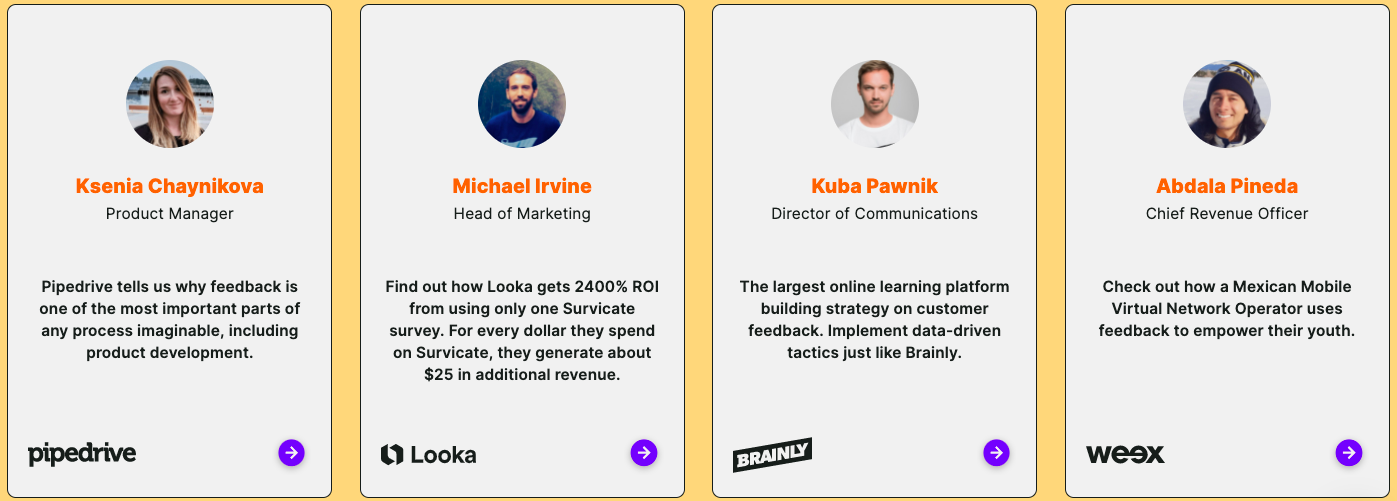
How to improve customer satisfaction?
Every brand should keep working to improve its customer satisfaction levels. But it’s not always that easy. It requires steady processes, defined company goals, and, most importantly, continuous effort from every team member.
So: how do you achieve customer satisfaction?
Let’s go through a few surefire ways to direct your customer experience program in the right direction and score some quick wins. And if you want to dig deeper into the topic, make sure to check out our guide on how to improve customer satisfaction in 8 steps.
1. Collect customer feedback & always be available
Your customers need a place to voice their opinions—both positive and negative.
Positive customer feedback will ensure that your product roadmap and customer support efforts are heading in the right direction. Happy clients might also share their ideas on improving your product and services, which will help you build a truly customer-centric business.
And an outlet for customers’ negative opinions lets them voice their frustration before turning to online communities.
Your customers should always be able to find a place where they can talk to you. To achieve it, combine the power of easily accessible customer service with the power of surveys.
Sure, not every company can afford 24/7 phone support—but solutions like chatbots and live chats made it easy to be available for your clients at all times.
They’ll let you catch your customers’ ad hoc requests, suggestions, and complaints. Just make sure there’s always a human out there ready to address problems a chatbot can’t fix.
It's also important to measure how helpful your support agents or helpdesk are when it comes to dealing with customer queries. You can do so easily with this simple survey:
💡 YOU MAY ALSO BE INTERESTED IN: Customer support survey template
On the other hand, surveys will help you gather general opinions about your brand and monitor the overall state of your customer experience program.
With proven customer satisfaction surveys like CSAT (Customer Satisfaction Score) or NPS (Net Promoter Score), you’ll gather numerical customer satisfaction data to monitor and benchmark. You can also give your customers room to voice their opinions by including open-ended questions (e.g., “Is there anything we could improve in our product to make it better for you?”)
Just take a look at the interactive NPS survey below. After the respondent assigns you a score, they can explain why they evaluated you the way they did and leave their suggestions. Satisfied customers also receive a request to leave an online review.
Free-to-use NPS survey template
After collecting customer feedback, calculate your general NPS score (to turn it into a benchmark and improve in the future) and check out the response breakdown! If you use Survicate, your NPS report will generate automatically.
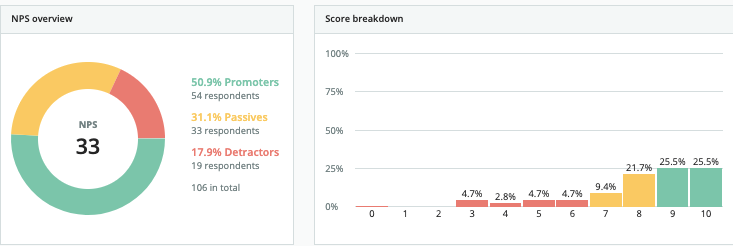
And don’t forget to look for valuable suggestions among the open-ended responses!
All in all, surveys are the best way to improve customer satisfaction and remove the guesswork from business decisions.
As one of our clients, Katja Lindqvist of Via Esca, told us,
Survicate surveys have given us a pretty good idea about why people decide to use our service, and why they stop using it. We are able to validate our ideas and theories against the actual reasons that people tell us about.
2. Stay proactive and react in real-time
Okay, so you brought suggestion number one to life, and your customers can always reach you.
Now, you have to make sure their feedback doesn’t disappear in a black hole—especially when it’s negative.
Ignoring customer complaints might have some severe side effects:
- You create an army of dissatisfied clients who are likely to churn, and that’s not the kind of audience you want.
- Dissatisfied customers are much more likely to share their opinions than happy ones, and a bunch of negative online reviews can seriously stain your reputation.
- Modern customers expect effortless interactions, so you don’t want to be recognized as a company that keeps inconveniencing its clients.
Whenever possible, address negative customer feedback in real time—or at least as soon as possible. Try to make things up for your unhappy customers, either by compensating them or bringing their suggestions to life. You might avoid negative word-of-mouth and get valuable ideas on how to improve your business.
Reacting in real-time doesn’t only concern live chats or phone calls but also surveys. With survey tools such as Survicate, you can set up email or Slack notifications and get heads up whenever someone shares their feedback.
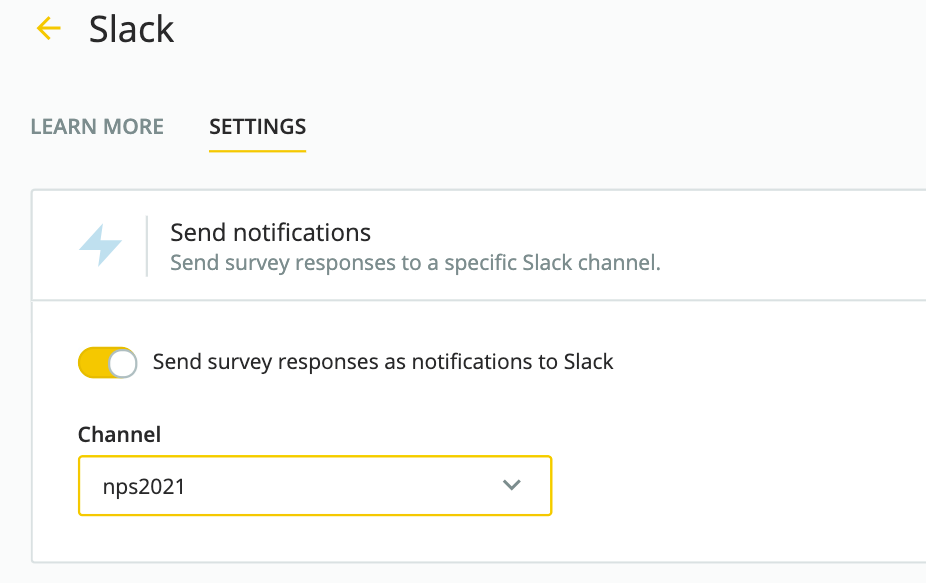
Sometimes it’s possible to predict a potential complaint and address it before it happens. Do you already know your web app will be under maintenance, and your users won’t be able to access it? Or maybe your store is swamped with orders, and you’re expecting shipping delays?
Stay transparent and let your customers know beforehand. Here’s an example of an email from the H&M online store:
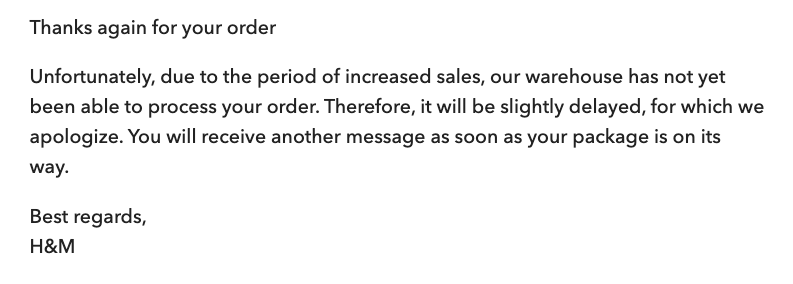
While customer complaints are often more time-sensitive than positive feedback, don’t ignore your satisfied clients, either. Always remember that they’re one of your most valuable assets. Try to:
- Keep track of your biggest fans;
- Turn their ideas into reality;
- Ask them for reviews or recommendations;
- Offer special deals;
- Turn them into brand ambassadors (with the help of referral programs or incentives).
The sky’s the limit.
3. Keep things personal
Personalization became the norm. So much that 61% of consumers expect brands to tailor experiences to their needs.
Business results confirm these claims. According to Google’s research, “90% of leading marketers say personalization significantly contributes to business profitability.”
It’s hardly surprising that personalization works so well since it makes the customers feel important and “at home.” After all, we’re all happy when we receive that free Starbucks coffee on our birthday, aren’t we?
From the company’s point of view, personalized targeting allows to tailor content production, services, and offers to the customers expectations. And a customer who gets exactly what they want is much more likely to feel satisfied—as opposed to a customer who gets spammed with irrelevant emails and still hasn’t understood how your product can help them.
A perfect example of effective personalization is the meditation app, Headspace. During signup, it asks the users a few simple questions about their preferences, such as experience level, the main reason for using the app, or their preferred meditation time.

Based on the customer’s choices, they can tailor the product and communication to users’ needs. The night owls will receive notifications later in the day when they’re the most engaged. Inactive users who want to sleep better will get content about improving their sleeping schedules. The people who installed the app to relieve anxiety won’t see sport-focused features, etc.
Hard to be dissatisfied when the product is exactly what you need it to be!
Make sure you apply personalization to all communication that comes from your brand, including surveys. For example, don’t just blindly show general user satisfaction surveys to everyone that visits your page—they might not even be your customers yet.
Instead, try triggering your survey based on an event, like completing a purchase or visiting a specific page. You can easily do it when setting up website surveys with Survicate.

4. Measure customer satisfaction regularly
You can’t improve customer satisfaction if you don’t know what you’re improving.
Measuring customer satisfaction with surveys will let you obtain concrete numerical scores and turn them into KPIs. You’ll also be able to look for patterns in open-ended questions and fix the most pressing problems.
Free-to-use customer satisfaction survey template
Here’s an example. Let’s say you recently ran a CSAT survey that revealed you have a lot of dissatisfied users. Their answers suggest they’re unhappy with the response time of your customer service.
You should try fixing the problem and then re-run the survey to see if your Customer Satisfaction Score improves. If it does—keep up the good work. If it doesn’t—investigate further. Maybe your audience didn’t reveal the actual source of their frustration, and you have to work on building a healthy communication flow?
Measure, tweak, and then measure again! You will:
- test your assumptions,
- motivate yourself to take action,
- and have interesting customer satisfaction data to show to the rest of your company.
If you run surveys with Survicate, you can always access a report section that will show you your scores and answer breakdown:

There are many customer satisfaction metrics methods to distribute your surveys to choose from. Pick the ones that fit your business goals and your clients’ preferred channels!
5. Communicate across departments
Imagine you’re a marketer who’s just run a customer satisfaction survey.
You got a pretty decent Customer Satisfaction Score, but you’ve received a few complaints from your least happy customers. You notice that most of them concern a particular bug in your app.
How do you think this situation should play out?
- The feedback stays in the marketing team and continues to create friction until the dev team notices the bug and fixes it one day;
- The feedback is shared with the dev team, who takes it seriously and fixes it at the earliest opportunity.
Obviously, the correct answer is b). Customer satisfaction requires input and effort from the whole company. Every department should take customer feedback seriously and realize the outcomes of ignoring it.
If you use Survicate, take advantage of the customer satisfaction tool’s unlimited seats and invite at least one person from each team to collaborate. They’ll have access to all the surveys and reports.
And if you integrate Survicate with Slack, you can set up notifications and simply tag the right people whenever feedback comes. Whatever fits the communication model in your company!

Improve your customer satisfaction with surveys
Customer centricity is an indispensable element of every successful business. This is why you should focus on continuously improving customer satisfaction.
High customer satisfaction levels help with:
- Keeping existing customers around;
- Attracting new ones;
- Increasing customer loyalty;
- Standing out from the crowd of competitions;
- Making smart product decisions.
Measuring customer satisfaction is essential for monitoring the state of your customer success and customer experience programs. It’s best to do it with the help of customer satisfaction surveys, such CSAT (Customer Satisfaction Score), NPS (Net Promoter Score), or CES (Customer Effort Score) surveys.
With customer satisfaction software such as Survicate, you’ll have your customer satisfaction surveys up and running in just a few clicks (with zero coding). Just choose one of our 125+ free customer satisfaction survey templates, customize it if you’d like, and watch the responses flow in. The combination of real-time response collection and data analytics means that you can thoroughly monitor your customer satisfaction. And, with Survicate's freemium plan, you'll get unlimited responses and unlimited users, so there is no excuse not to zoom in on your customer satisfaction levels. Sign up for your free plan and put customer voices at the heart of your business right now!

.webp)






.svg)
.svg)
.svg)

.svg)


.svg)







.svg)




.svg)

















.svg)






























.svg)

.svg)
.svg)

.svg)



.svg)




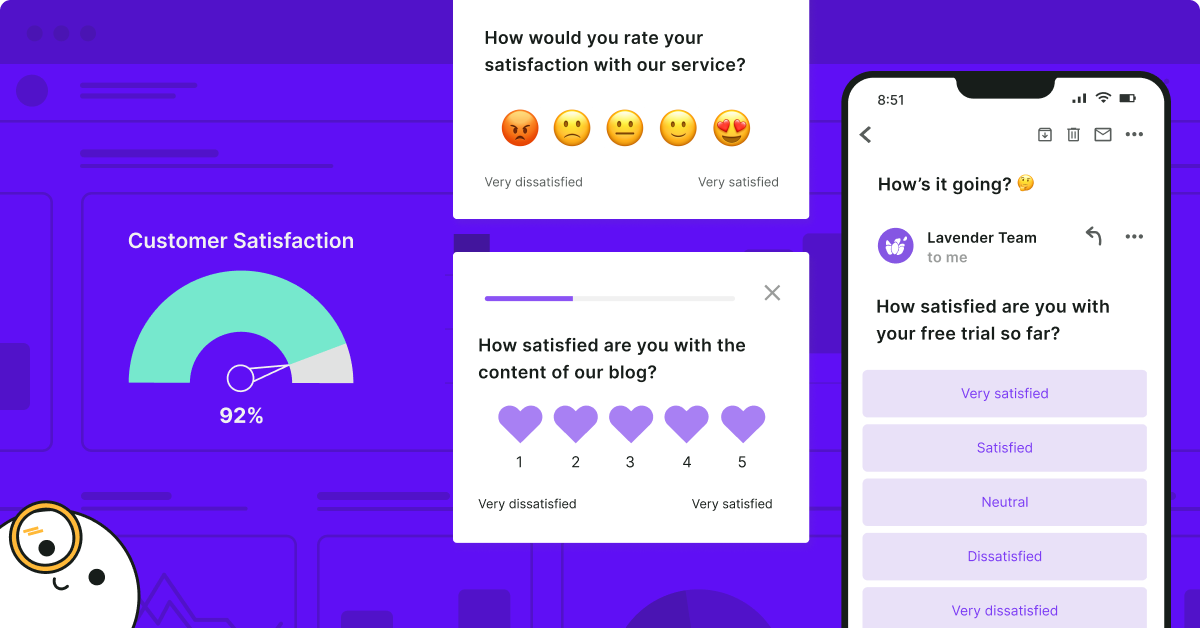

.svg)

.svg)
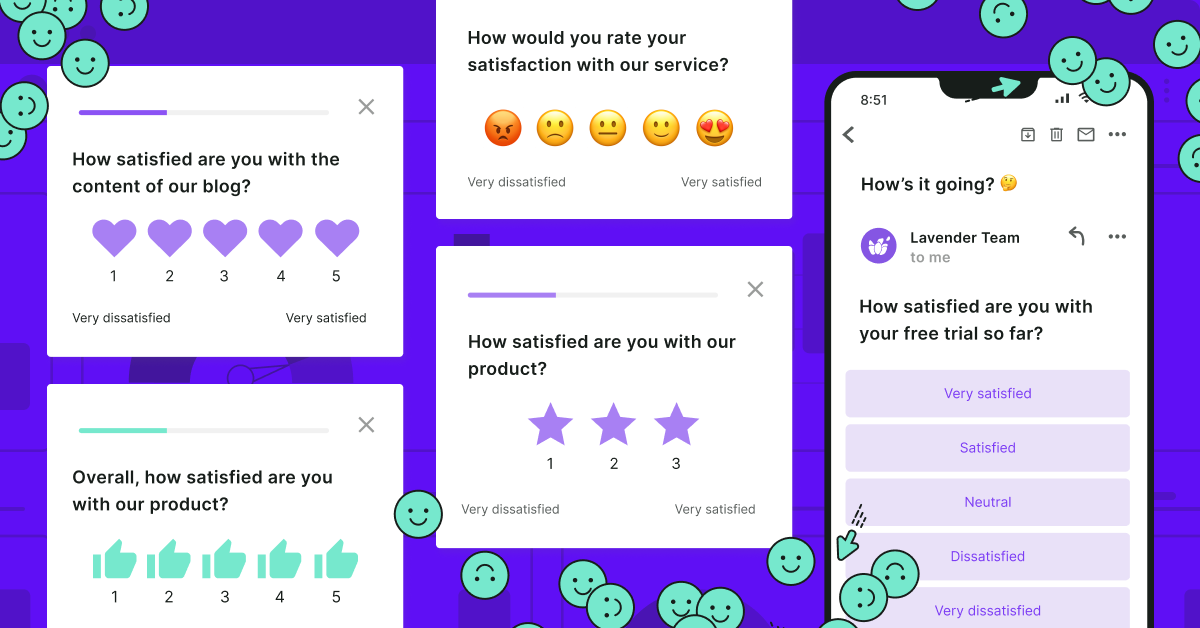
.jpg)





